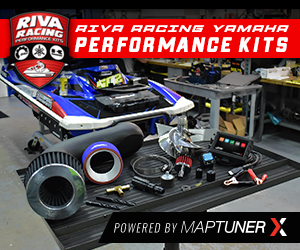Getting the optimal performance out of your supercharged personal watercraft really isn’t all that difficult – that is, if you follow the guidelines outlined by the owner’s manual and manufacturer’s recommendations. In the case of our 2018 Sea-Doo RXT-X 300, we had just surpassed 50 hours on the clock and knew it was time for service.
Although it’s best to have your local dealer’s service department or certified BRP mechanic tackle your ski’s service, many of you are the do-it-yourself types – like ourselves – so we’re going to show you how we recommend changing the oil, filter and spark plugs, with a few extra steps to ensure your machine runs its very best.
First, we ordered the official Sea-Doo 4-Tec 300 HP Oil Change Kit from the Greenhulk PWC Performance Store. It comes with a gallon of XPS’ 5W-40 Synthetic Blend “Summer Grade” Oil, as well as the oil filter and o-rings. You won’t be needing the whole gallon, but it’s nice to have an extra quart handy. We also picked up three NGK Spark Plugs.
Next, we picked up a Hydro-Turf Fluid Extractor to siphon the oil out of the dip stick tube. Hydro-Turf offers an optional 15-liter version, but the 6-liter pump was all we needed for the work we were doing today.
Most all technicians agree that it’s all but impossible to siphon out all of the old, dirty oil, which we believe to be true. That is why we picked up a gallon of generic store-brand 5W-40 synthetic blend to use as – what we like to call – sacrifice oil. More on that in a minute.
As always, we begin by disconnecting the battery. Next, we start easy enough by removing the two-piece seat and the engine inspection cover. Don’t forget that in addition to the 10 torx head screws along the sides that there are 3 more hidden under the ski pylon cover plate. With the engine compartment fully exposed, working on the Sea-Doo is remarkably easy.
Our dipstick read slightly above the fill line, which is spot on when the engine is cold. Too often, people overfill their engine oil, which produces a windage effect inside of the crankcase. Windage slings oil under the pistons, connecting rods and crank, and can actually slow down their rotation, decreasing RPMs.
Over-filling the oil level can also result in potentially damaging crankcase pressure, pushing super-heated vaporized oil out of the crankcase and back into the engine’s intake, coating the intercooler in a thick film that reduces the intercooler’s effectiveness.
Earlier this year, we explained in great detail the detriments of oil windage, excessive crankcase pressures (ie. atmosphere) and how to avoid it. We strongly recommend you click this link to go back and look it over.
RIVA Racing’s own Brian Rosencrantz cautioned, “A common cause of poor performance is over-filled engine oil. Failure to follow the correct procedure will result in the ski being over-filled. This causes decreased engine performance due to windage losses in the engine.”
So again, we were cognizant not to exceed the recommended 3 quarts of oil. Carefully feeding our fluid extractor into the dip stick tube, we sucked out just a little under 3 quarts of burnt, spent oil. Knowing that a few ounces of the old oil remained inside and not wanting it to contaminate our fresh XPS oil, we poured in 3-quarts of our cheap “sacrifice oil”.
The sacrifice oil does a couple things: it helps wash out any lingering carbon deposits around the pistons that could contaminate our high grade XPS oil, as well as dilute the remaining ounces of old oil enough for our extractor to suck them out. Obviously, we matched both the synthetic blend and weight to the XPS oil.
We then turned on the hose and let the engine idle for a little over a minute. Although not mandatory, this extra step helps flush out the remaining deposits inside of the crankcase, ensuring that our XPS oil won’t be contaminated as we pour it in.
Using our extractor we then withdraw the sacrifice oil and poured in our XPS oil. BRP insists on using a synthetic blend, which means a blend of mineral oil (conventional or crude) and synthetic base oil. Due to their unique tight-knit molecular bond, synthetics allow for lower viscosity grades like 0W-20, ideal to improve fuel economy.
The problem is that these lower viscosity oils don’t wick or dissipate heat like heavier, conventional-based oils. Equally, synthetic oils are far “slicker” than crude/mineral oils. Normally, this attribute is preferred among oils, but for Sea-Doo, the slicker oil permits too much slippage between the supercharger clutches and can quickly burn up these sensitive components.
With an engine filled with fresh XPS oil, we removed the old oil filter. The filter is enclosed by a sealed lid that uses two rubber o-rings. The filter is attached to the lid by a rubber grommet, meaning replacing it simply means popping the old one off and replacing it.
Whether the o-rings look good or not, we recommend replacing them as the service kit comes with new ones anyway. With those replaced, we applied a little bit of fresh oil to the rings and reinstalled the filter and lid, tightening the lid snug.
To complete our service, we needed to swap out our spark plugs. The decorative engine cover is easy to remove; just take out the dip stick, and unsnap the two pegs holding the cover to the intake manifold. Next, we unplugged each of the coil packs from the harness. Each coil is attached to a snap-and-prong connector, so just press down and slide each one back.
Each coil pack is held down by a torx head screw. Back each one off and remove the respective coil pack. Using a spark plug socket and a long extension, we removed each plug and observed the discoloration of each electrode. Using a simple dial indicator, we saw all 3 spark plugs fell within the .025-thousands to .030-thousands range, per the service manual.
It’s always wise to double check the spark plug gap – pre-gapped plugs are often close, but shouldn’t be blindly trusted. We manually gapped each new spark plug’s electrode to .028-thousands of an inch. BRP’s service manual suggests applying some anti-seize to the threads before torquing each plug to 17 lbs. feet. Most mechanics often call this “snug”, which is just a twist over hand-tight at best.
Next, reinstall each coil pack, making sure there’s no debris to interfere terminal. Plug each coil back into its respective socket, and snug down each screw. Content with our work, we reconnected the battery, turned the hose back on, and fired up our newly serviced RXT-X 300.
In order to preserve our carbon ring seal as long as possible, we didn’t let the engine warm up longer than a minute or two. The carbon seal is only cooled when it’s in the water – whether idling in one spot or at speed – so letting it spin out of the water too long can damage the sensitive part.
But that’s not all for our 2018 Sea-Doo RXT-X 300. We also got our hands on a RIVA Racing Speed Control Override Module. Believe it or not, this one product can unlock the hidden potential within the Sea-Doo RXT-X 300, allowing it to run at a sustained 74-plus-miles per hour.
It does this by interrupting the signal to the factory-installed GPS-monitored speed control function in the craft’s iControl brain, which maintains the Sea-Doo at a United States Coast Guard-approved 68-plus-miles-per-hour. Please understand that it does not reprogram the ECU or permanently alter the performance or every day function of the watercraft. It is 100-percent reversible and non-invasive.
Using a paper template provided in the instructions, we marked the two holes where we will drill – careful to align properly to give the SCOM plenty of room away from the reservoir bottle. Drilling the Sea-Doo’s proprietary CM-Tech deck makes quite the mess so we laid down a towel to catch most of the dust.
Using a smaller bit to drill our pilot holes, we then used the supplied bit to open the holes wider. We also used a larger bit to countersink the holes, so the supplied mounting bolts would lay flush to the surface. RIVA provides nylock nuts that won’t back off or vibrate loose. Tighten these with a 10mm box-end wrench.
With our SCOM mounted, we next removed the harness diagnostic cable from the reservoir socket and plug it into the module. We then plugged the SCOM’s lead into the reservoir socket, taking the factory plug’s place. With that complete, we reattached the positive terminal to the battery and readied to fire up our newly “unrestricted” RXT-X 300. Before we did though, there was one new trick we wanted to try:
The RIVA SCOM allows for the Sea-Doo to be set into “Sport Mode” before starting the ignition. All you have to do now is tap the Start/Stop button, allowing the gauge cluster to wake up. Then you can set your ski to “Sport Mode” like you would normally when the engine was running, by tapping the Sport button once, and once more to confirm.
Either selecting Sport Mode before ignition or after, the 2018 Sea-Doo RXT-X 300’s arm-stretching acceleration remained the same. It was only as we crept up past 68 miles per hour did the SCOM truly prove its worth. With our trim set at 5/8 an a few gallons of gas in the tank, we continued to see gains the longer we held into the throttle.
Wanting to record our progress, we selected the top speed feature on the Sea-Doo’s dash board as well as recorded our top speed using both our Garmin GPS and a top speed app on our iPhone 8. What we saw – 75 miles per hour at 8,040rpm – was truly impressive, especially on a bone stock 2018 Sea-Doo RXT-X 300.
Take into account that these speeds were achieved with a 240-pound pilot riding at an elevation of 450 feet above sea level, and riding with our aggressive-handling RIVA Pro Series sponsons set at the 4th lowest position (which admittedly, were probably responsible for some drag); it’s pretty exciting stuff, especially when speeds like these took literally thousands of dollars in aftermarket parts and tuning just 10 years ago – and a huge testament to the power the factory Sea-Doo is putting out.












































[…] real results – especially when used in ideal conditions. On a ’18 RXT-X 300 with 50 hours, we hit 75mph with a pretty full tank and several hundred feet above sea level – others have seen upwards to 77-78mph. And best of all, it’s 100-percent reversible meaning it […]